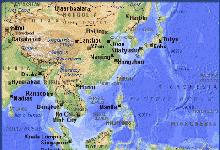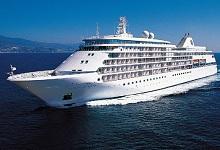Recently Viewed Cruises
- Oceanic Discoverer
- Ab Fab Oosterdam
- Catch up on Cruising: Latest cruise news in bite size
- Catch up on Cruising: Latest cruise news in bite size
- Catch up on Cruising: Latest cruise news in bite size
- Frequently Asked Questions
-
Shadow, Voyage 3329 ex Tokyo to Shanghai
Nights 10 Ship Silver Shadow Star Rating 
Departs Tokyo, Japan Sailing 2013: 29 Sep Ports of Call Tokyo, Hiroshima, Busan, Jeju, Tianjin, Shanghai Select a sailing date for approximate pricing.
Prices are per person, twin share. When booking please check current cruise fare and inclusions. Prices are indicative only, subject to currency fluctuations and may change at any time without notice.
10 Night Cruise sailing from Tokyo to Shanghai aboard Silver Shadow.
Launched in 2000, Silver Shadow introduced guests to the next generation of the Silversea fleet - slightly larger in size, yet just as intimate in feel. In addition the the added space, guests aboard the Shadow are greeted with Silversea's six-star personalised service and attention to detail. The Shadow is as elegant as a grand hotel, as gracious as a long-time friends' home. Each all ocean-view suite provides a sumptuous retreat. Each public space is intimate yet inviting. It's a warm feeling of home upon the seas of the earth.
Aboard Silver Shadow you will find a most accommodating place to view our world. Whether it's delicious onboard diversions, world-class cuisine, memorable dining venues or staying connected from anywhere, Silversea's impeccable standards apply to every detail of your voyage.
Highlights of this cruise:
Tokyo
Of all major cities in the world, Tokyo is perhaps the hardest to understand or to see in any single perspective. To begin with, consider the sheer, outrageous size of it. Tokyo sprawls 88 km (55 mi) from east to west and 24 km (15 mi) from north to south. It's an area of 590 square km (228 square mi) that houses some 8 million people. Tokyo has no remarkable skyline, no prevailing style of architecture, no real context into which a new building can fit. Every new project is an environment unto itself. Architects revel in this anarchy, and so do the designers of neon signs, show windows, and interior spaces. The kind of creative energy you find in Tokyo could flower only in an atmosphere where there are virtually no rules to break.
Busan
Busan is South Korea's second largest city, and its principal port. It is also the only major South Korean city to have escaped capture by the communists during the Korean War, when its population was increased by an unbelievable four million refugees. Although the city is nestled between mountain ridges and peaks, its port has given it an outward orientation, and a certain cosmopolitan ambience has resulted from the constant exposure to sailors from all over the world. Lovely beaches, scenic cliffs, mountain panoramas, and hot springs are all found within the city. Under the new Romanisation system promulgated in 2000, Pusan, as the city was formerly called, is now spelled Busan.
The earliest outside influences came from the Chinese, and you will notice many similarities in the two cultures. During the Three Kingdoms Period, Korea experienced a remarkable flowering of the arts, architecture, literature and statecraft. Chinese influences were absorbed, re-interpreted, and mingled with traditional Korean beliefs. Perhaps the single most formative influence was Buddhism, which became the state religion. One of the three dynasties was the Silla, which united the Korean peninsula for the first time, and presided over its greatest era of cultural development, apparent in the countless tombs, temples, pagodas, pleasure gardens and palaces which dot the countryside, especially in Gyeongju, the former Silla capital.
Tianjin
Beijing's 13 million official residents-plus another 2 million migrant workers-are a fascinating mix of old and new. Early morning taiqi (tai chi) enthusiasts, bearded old men with caged songbirds, and amateur Peking opera crooners still frequent the city's many charming parks. Cyclists no longer clog the roadways; although you will still find bike lanes, the city's broad thoroughfares are now ruled by China's steadily increasing number of car owners. As the seat of China's immense national bureaucracy, Beijing still carries a political charge. Mao-style propaganda persists. Slogans that preach unity among China's national minorities, patriotism, and love for the People's Liberation Army (the military arm of the Communist Party) still festoon the city on occasion. Yet as Beijing's already robust economy is boosted even farther by the massive influx of investment prompted by the 2008 Olympics, such campaigns appear increasingly out of touch with the cell-phone-primed generation. The result in the streets is an incongruous mixture of new prosperity and throwback politics, a land of opposites where the ancient and the sparkling new collide.
Shanghai
Shanghai, one of the most vibrant and exciting Chinese cities, once known as the Paris of the East, now calls itself the Pearl of the Orient. A port city, lying at the mouth of Asia's longest and most important river, Shanghai is famous as a place where internationalism has thrived. Today the city draws more parallels to New York City than Paris. It is laid out on a grid (unlike sprawling Beijing), and with a population of 16 million, it is one of the world's most crowded urban areas. The Shanghainese have a reputation for being sharp, open-minded, glamorous, sophisticated, and business-oriented, and they're convinced they have the motivation and attitude to achieve their place as China's powerhouse. Shanghainese enjoy one of the highest living standards in China. Higher salaries and higher buildings, more business and more entertainment-all these define the fast-paced lives of China's most cosmopolitan and open people.







